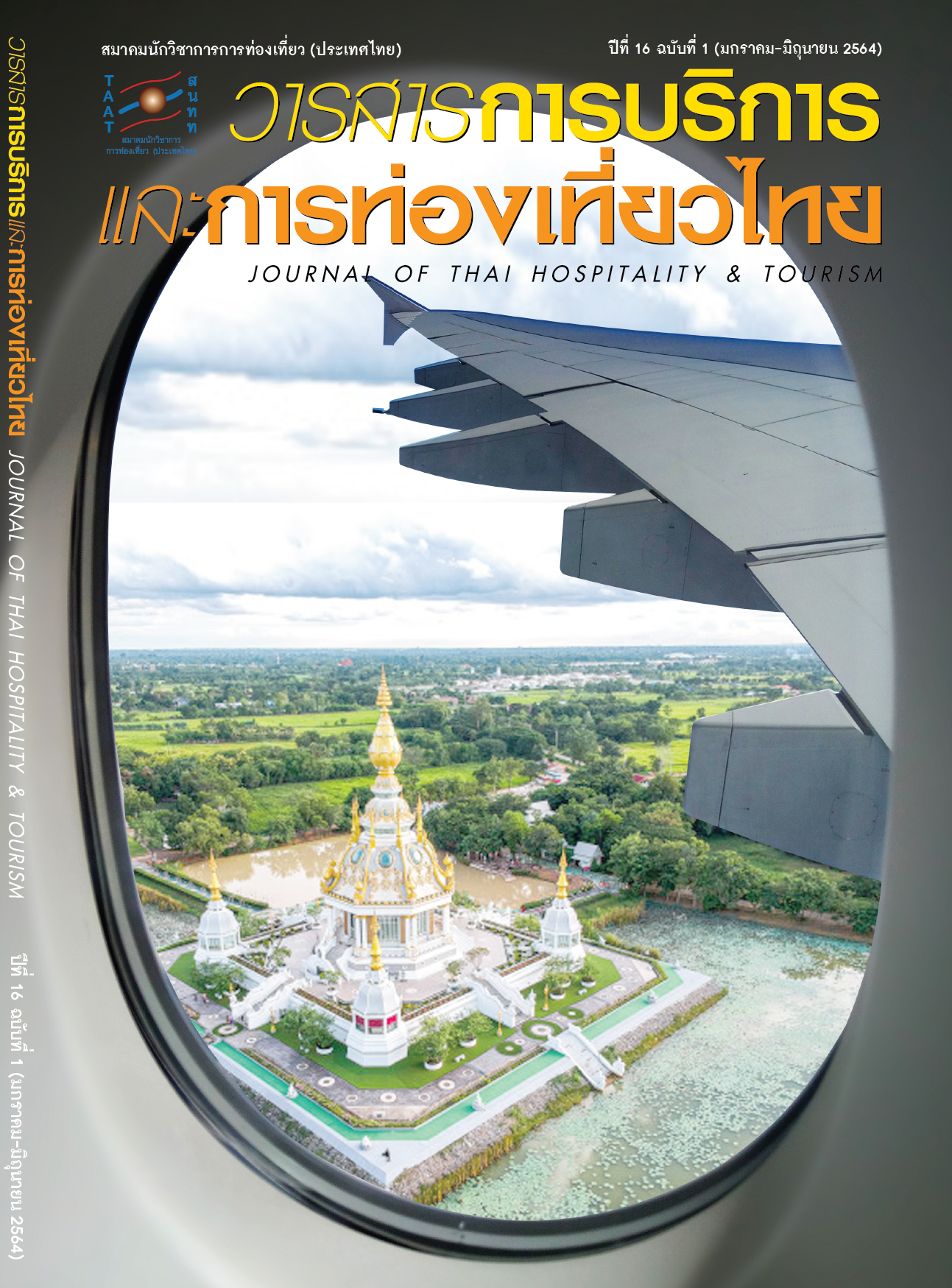พฤติกรรมของนักท่องเที่ยวชาวอาหรับในกรุงเทพมหานคร
Main Article Content
บทคัดย่อ
บทความวิจัยนี้มีวัตถุประสงค์ เพื่อศึกษาพฤติกรรมและแรงจูงในของนักท่องเที่ยวชาวอาหรับที่เดินทางมาท่องเที่ยวในกรุงเทพมหานคร โดยใช้แบบสอบถาม จำนวน 100 ตัวอย่าง ด้วยวิธีการสุ่มตัวอย่างแบบบังเอิญ ในการเก็บรวบรวมข้อมูล การวิเคราะห์ข้อมูลใช้การทดสอบทางสถิติแบบ ความถี่ ร้อยละ และ สถิติเชิงอนุมานแบบ Pearson Chi-square ผลการวิเคราะห์พบว่า กลุ่มตัวอย่างนักท่องเที่ยว นิยมมาท่องเที่ยวกับครอบครัว ใช้ระยะเวลาในการท่องเที่ยว 1-2 สัปดาห์ สถานที่ที่นิยมไปเที่ยวได้แก่ มาบุญครอง ซาฟารีเวิร์ล และดรีมเวิร์ล โดยมีแรงจูงใจในการมาท่องเที่ยวเพื่อความผ่อนคลาย และเข้ารับการบริการด้านสุขภาพและความงามเป็นอันดับต้น รูปแบบของสถานที่ท่องเที่ยวที่ชาวอาหรับต้องการคือ สถานที่ที่สะดวกสบายแม้ว่าจะไม่เป็นที่นิยมก็ตาม การวิจัยครั้งนี้ยังทดสอบสมมติฐานทางสถิติเพื่อดูความแตกต่างอย่างมีนัยยะสำคัญของตัวแปรพบว่า ปัจจัยส่วนบุคคลด้าน เพศ สัญชาติ รายได้ และรูปแบบการเดินทาง มีผลต่อความแตกต่างด้านพฤติกรรมการท่องเที่ยวและแรงจูงใจในการท่องเที่ยว ผลการวิจัยครั้งนี้สามารถนำไปใช้วางแผนพัฒนาการท่องเที่ยวเพื่อรองรับความต้องการของนักท่องเที่ยวกลุ่มดังกล่าวที่มีแนวโน้มสูงขึ้นเรื่อยๆ
Article Details

อนุญาตภายใต้เงื่อนไข Creative Commons Attribution-NonCommercial-NoDerivatives 4.0 International License.
เอกสารอ้างอิง
AC Nielsen. (2002). Study on Promoting Malaysia as a Tourist Destination for the Middle East Market. AC Nielsen Malaysia.
Alreshaidan, F. (2016). An Analysis of Saudis International Pleasure and Leisure Travel Behavior. Retrieved December 10, 2017, from http://eajm.webnode.com/table-of-contents/a2006
Baharan, R. & Ghalip, A. Y. (2006). Push and Pull Factors Influencing Arab Travelers to Choose Malaysia as Their Choice Destination. Euro Asia Journal of Management, 16(2), 167–184.
Cobos, M. A. V. (2008). Market Potential of Middle East Tourists in Thailand. Master’s Thesis, Department of Hospitality and Tourism Management, Faculty of Business Administration, Prince of Songkla University.
Cruz–Milan, O. (2017). Plog’s Model of Typologies of Tourists. Retrieved from http://www.academia.edu
/31650779/Plogs_Model_of_Typologies_of_Tourists
Daleesah Dahyee, Naphatsanan Vinijvorakitkul & Poramet Boonnamsirikit. (2014). Behaviors in Tourism of Middle East Tourists in Bangkok. Journal of International and Thai Tourism, 10(2), 1–13.
Darin Patimeteeporn. (2013). Work Motivation Related to Job Performance Efficiency of Employees in Private Air Cargo Company in Bangkok Metropolis. Retrieved from http://thesis.swu.ac.th/swuthesis/Man/Darin_P.pdf
Hudson, S. (2008). Tourism and Hospitality Marketing: A Global Perspective. London: SAGE Publications.
Ibrahim, Z. et al. (2009). Travelling Pattern and Preferences of the Arab Tourists in Malaysian Hotels. International Journal of Business and Management, 4(7), 3–9.
Maslow, A. H. (1970). Human Needs Theory: Maslow’s Hierarchy of Human Needs. In Craven, R. F. & Hirnle, C. J. (Eds.), Fundamental of Nursing: Human Health and Function. 3rd ed. Philadelphia: Lippincott.
Ministry of Tourism and Sports. (2016). Tourism Economic Review. Retrieved from
http://www.mots.go.th/ewt_dl_link.php?nid=8265
Pizam, A. & Sussmann, S. (1995). Does Nationality affect Tourist Behavior? Annals of Tourism Research, 22(4). 901–917.
Plog, S. C. (1974). Why Destination Areas Rise and Fall in Popularity. The Cornell Hotel and Restaurant Administration Quarterly, 14(4), 55–58.
Soraya Homchuen. (2002). Muslim Tourist Market. Tourism, 2, 46–61.
Thai Civil Rights and Investigative Journalism. (2016). Middle Eastern Tourists Increased by 5.5% in 2016. Retrieved from http://tcijthai.com/news/2016/14/scoop/6413
Thaleugsak Intharason. (2011). The Motivation and Performance of Security Personal in King Mongkut's University of Technology Thonburi. Retrieved from http://www.thapra.lib.su.ac.th/objects/thesis/fulltext/snamcn/Thaleugsak_Intharason/fulltext.pdf
Thansettakij. (2016). Thailand Tourism had A New Record that Hit 2.33 Trillion. Retrieved from http://www.thansettakij.com/content/25115
Wassana Suwannavijit. (2014). Factors Influencing Tourists’ Decision Making to Travel to Indonesia–Malaysia–Thailand Growth Triangle (IMT–GT): Only within Thailand Area. Journal of Thai Hospitality and Tourism, 9(1), 18–33.
Wong, Y. B. (2001). Analysis of Middle East Market in Malaysia: Perception of MTPB in Positioning Malaysia as a Tourist Destination to Middle East Market. Unpublished Paper, Taylors’ College.


